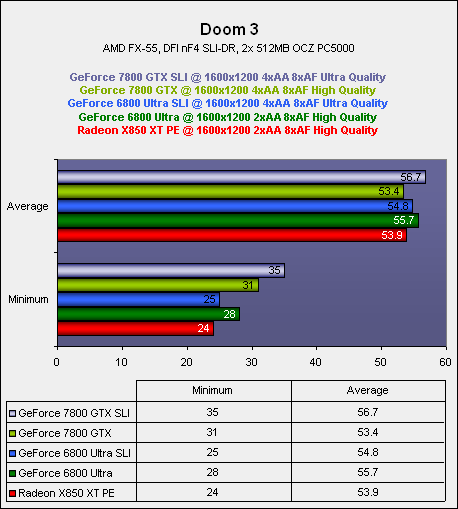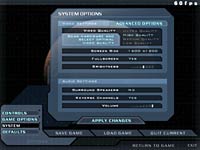
Doom 3
Publisher: ActivisionWe are using the full retail version of Doom 3 patched to version 1.1 and we used a section of the “Caverns” level to do a manual run through for the purposes of this comparison. Anti-Aliasing and Anisotropic Filtering were configured from inside the game, and thus we've left the drivers set to “Application Controlled”.
Due to the darkness of Doom 3, we find that increasing the resolution has greater image quality benefits than applying AA to a lower resolution.
In Doom 3, we had previously found that GeForce 6800 Ultra SLI was already playable at the maximum in game details available for this title. In the updated Forceware 77.62 driver, we didn't notice any differences in the quality of the game play and were still able to achieve a smooth gaming experience at 1600x1200 4xAA 8xAF with Ultra Quality in-game details.
The GeForce 7800 GTX in a single card configuration delivered acceptable performance at 1600x1200 4xAA 8xAF with High Quality in-game details. It was slightly disappointing that the GeForce 7800 GTX was not able to play with Ultra Quality in-game details, but the difference between the two settings is not massive. We experienced a little too much hitching, with our minimum frame rate dropping in to the low 20's at Ultra Quality.
When we added a GeForce 7800 GTX in to the fray, we found that we were able to play at the same settings as GeForce 6800 Ultra SLI – 1600x1200 4xAA 8xAF with Ultra Quality in-game details. We believe that with a 512MB frame buffer, it might be possible to get GeForce 7800 GTX SLI to run at 1600x1200 with 8xAA 8xAF Ultra Quality. However, we will have to wait for a 512MB version of the card to appear before we can check this out.
The two previous generation cards are fairly well matched, with both GeForce 6800 Ultra and Radeon X850 XT Platinum Edition delivering a smooth gaming experience at 1600x1200 2xAA 8xAF with High Quality in-game details.

GeForce 6800 Ultra was faster than Radeon X850 XT Platinum Edition – roughly two frames per second in terms of average frame rate, and a difference of 24 to 28 FPS when examining the minimum frame rate. GeForce 7800 GTX was considerably faster than both of these video cards in a single card configuration.

MSI MPG Velox 100R Chassis Review
October 14 2021 | 15:04







Want to comment? Please log in.